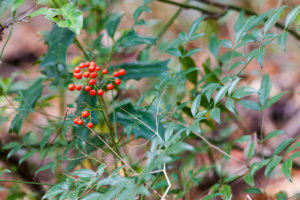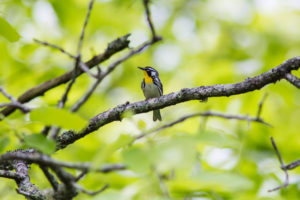Help us remove invasive plants with Bucks for Birds!

This spring, we’re attacking two invasive plant species in the Old Forest–nandina and mahonia–and we need your help to do it! Because both plants’ seeds are spread by birds, and nandina’s toxic berries can actually poison and kill them, we decided to let the birds help us out in our fundraising for this effort.
This April, we invite you to participate in our Bucks for Birds campaign by pledging a certain amount for every species of bird we’re able to photograph in the Old Forest during the month. If you pledge $1 per bird and we spot 50 species, at the end of the month your contribution will total $50. Those funds will be used to cut and treat nandina and mahonia plants that are choking out native species and poisoning birds.
Along the way, we’ll be posting regular updates sharing each new species we’ve spotted. Check back here several times a week to learn about the abundance of birds passing through town!
How does it work?
Simply visit our Bucks for Birds page on PledgeIt at www.pledgeit.org/bucksforbirds. Click the “Pledge Now!” button and you’ll be asked to choose a dollar amount per bird. You can enter any amount–whether that’s 50 cents, a dollar, or $10–and your pledge will be multiplied by the number of species we photograph in April. (You can also make a flat one-time donation.) You’ll quickly create an account and enter your payment information, and then you’re done! Just visit our blog throughout the month to track our progress, and your credit card will be charged a single time at the end of the month after we’ve entered our final species tally.
The website is accepting donations now, so go ahead and make your pledge!
 Why April?
Why April?
The peak of spring bird migration, during which birds travel hundreds or thousands of miles northward to their breeding grounds, reaches the Memphis area in April. The amount of bird species we might see in the Old Forest doubles in April vs. during the winter months. Many of these birds will only spend a day or two here, resting and feeding, before taking off again. Habitats like the Old Forest, with large swaths of green visible from the air, are crucial stopovers on the birds’ long journey.
Beyond the heightened numbers, the types of birds present in spring are some of the most beautiful. Migration is our chance to see several dozen species of wood-warblers, which are small, often brightly-colored birds that winter in Central and South America and breed in Canada. Here are some of the birds we might see.
Last year during migration, we recorded 45 different species. Think we can beat that number this year?

Why remove these plants?
There are several dozen non-native species in the Old Forest, and the Conservancy has been prioritizing their removal based on how invasive they are. We spent the winters of 2012 and 2013 removing 2,000 cubic feet of Chinese privet, some of which had reached tree height. Since that major removal project, we’ve continued to cut and treat waist-high privet plants each winter while monitoring new sprouts for future treatment. Volunteers have also been assisting with the removal of kudzu and English ivy, and this winter Park Friends has targeted wintercreeper vines.
We work incrementally to remove invasive plants so that we can get a certain species under control. Focusing on one or two species at a time allows us to be efficient and precise, because the control methods we use will be different for different species.
The next two plants on our priority list are nandina and mahonia, two shrubs native to Asia that appear throughout the Old Forest. Like many invasive plants, they were brought over as ornamentals and escaped into natural areas, partially with the aid of birds who ate their berries and dropped the seeds elsewhere. Nandina in particular is harmful to birds–its berries contain cyanide and are poisonous to dogs and cats as well as birds. Cedar waxwings in particular are vulnerable to nandina because they are so fond of berries, and nandina can kill a bird within an hour.
By attacking these plants, we’re preventing them from spreading further, making it easier for native plants to spring up in their place, and avoiding unnecessary bird death.



